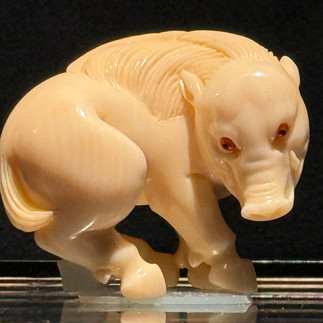TOKYO NATIONAL MUSEUM
- chuckmeltzer
- Jun 22
- 4 min read
Updated: Jun 23
We hired a guide to take us through the Tokyo National Museum with a goal to learn something about Japanese art. People from the West (which means me) are familiar with western art from the renaissance to impressionism and abstract expressionism, but learning about Asian art is not something one gets taught much in an arts humanities class in college.
At the gallery, we had the pleasure of being guided by Rafa, the most organized and exceptional guide we've ever encountered. Rafa, a Sephardic Jew and a PhD in architecture, began by sitting down with us to provide a brief lecture on Japanese culture before we explored the museum galleries. He aimed to deepen our understanding of how the traditional art in the museum was influenced by history and culture. The extensive collection features numerous objects, sculptures, and paintings, including samurai swords and kimonos.
Japanese paintings are distinctive because an object, such as a branch, might be only partially shown on the canvas. Furthermore, the artists choose to leave sections of the canvas unpainted instead of filling every space.
Below are samurai warrior outfits; can we say Darth Vader?
I especially enjoyed the netsuke, which are small carved collectibles.
Our guide, Rafa, encouraged us to view Japan as a bowl of rice. While rice alone is uniform, considering what contributes to this bowl of rice makes it far more intriguing. The elements of this bowl begin with the individuals who introduced Buddhism to Japan from China and India. It includes those who traded from the Netherlands and France, and finally, the influence of World War II, when the US occupied Japan for several subsequent years.
Shinto is another component of this bowl of rice and it has existed in some form from around 400 BC until Buddhism arrived in Japan in 600 AD. Shinto focuses on life, whereas Buddhism centers on death. Shinto features shrines with torii (gates) and priests, while Buddhism has temples and monks. Approaching a Shinto shrine involves following a winding path, while a Buddhist temple is approached in a straight line.
Wabi-sabi is a Japanese philosophy that appreciates beauty in imperfection, transience, and the natural flow of life. It encourages accepting flaws and focusing on the simple, rustic, and authentic, often finding beauty in what is overlooked or discarded. In life, it promotes humility and gratitude for what is, rather than striving for more. This perspective does not drive potential overachievers to exceed the status quo. In nature, wabi-sabi explains the beauty of landscapes that are more natural than a formal French garden. In art and design, wabi-sabi is evident in pottery, where imperfections are cherished. It promotes natural, simple, and raw aesthetics.
The governance of Japan significantly influenced its culture, particularly during the Edo (1603-1868) and Meiji (1868-1912) periods. The Edo era was defined by isolationist policies, a strict social hierarchy, and economic growth within a feudal system. Although Kyoto was the capital from 794-1869, the Tokugawa shogunate operated from Edo Castle in Tokyo, which later became the capital during the Meiji Restoration. This restoration marked the end of the Edo period and began a phase of rapid modernization, including the adoption of Western technology, the establishment of a constitutional monarchy, and military expansion.
In the Edo period, the Tokugawa enforced a strict social hierarchy, with the emperor as a symbolic figurehead and the shogun as the ultimate military leader. Society was rigidly structured, with the samurai (warrior class), peasants, artisans, and merchants occupying various levels. Japan pursued a policy of national isolation, limiting foreign trade and travel.
Commodore Perry was instrumental in ending Japan’s long period of isolation. In the 1850s, he led an expedition that compelled Japan to open its ports to trade and diplomatic relations with the West. Perry arrived in Tokyo Bay with a fleet of technologically advanced black ships. His approach, known as “gunboat diplomacy,” used military force as a negotiation tool, effectively achieving his goals. Perry’s actions led to Japan’s modernization and global engagement, and it’s speculated that these events influenced Japan’s later military campaigns in China, Malaysia, and eventually Pearl Harbor.
The Meiji period marked the end of the shogunate. Japan’s openness to Western trade and influence led to significant social, political, and economic transformations. The Meiji government heavily invested in military modernization. The young samurai who led the rebellion against the Tokugawa shogunate were concerned about foreign encroachment and feared Japan might face the same imperialist pressures affecting China. They aimed to revise unequal treaties with foreign nations, adopting a strategy to enrich the country and strengthen the military to stand equal with Western powers. The Meiji period concluded with Emperor Meiji’s death in 1912.
Regarding the attack on Pearl Harbor, historians suggest it was provoked by embargoes in 1940-41 on scrap metals and petroleum products crucial for Japan’s war efforts. Some revisionist historians even propose that Roosevelt deliberately provoked Japan to prompt the US to declare war and support allies in Europe. The truth of this speculation remains uncertain.





























































Comments